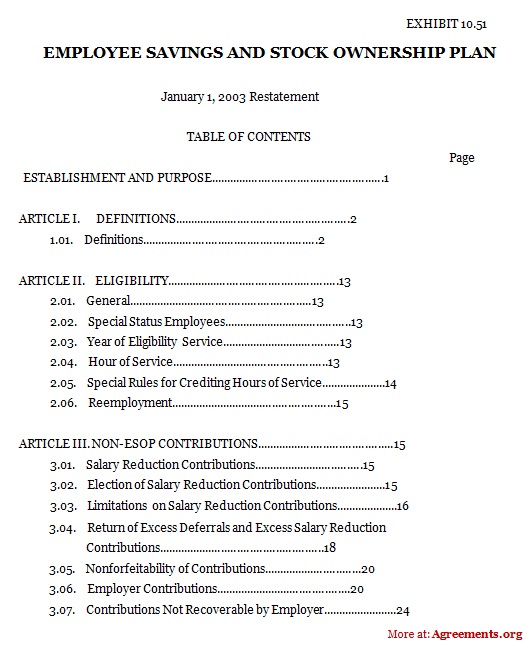An employee savings and stock ownership plan agreement is an employer-provided qualified retirement plan that gives the employees an equity interest in the company. The employees are provided with stock ownership, typically at no added or up-front cost, as a part of the retirement plan of the employees in lieu of the work performed by them for the company. The shares allocated to the employees are typically kept in trust until those employees retire or leave the company. The shares are then sold, either back to the employee stock ownership plan or to the company. The company can often benefit from increased cash flow, tax savings, and increased productivity from highly motivated employees.
Purpose of An Employee Savings and Stock Ownership Plan Agreement?
What is ESOP? An employee stock ownership plan serves the dual purpose of retaining a high performing and meritorious employees and giving the company some extra cash flow. It also allows employees to acquire beneficial ownership of their company without investing their own money. Such employee plans are generally tax-exempt.
Inclusions in an Employee Savings and Stock Ownership Plan Agreement?
Apart from complex commercial and technical clauses, certain standard boilerplate clauses such as dispute resolution, choice of law, severability, entire agreement, waiver, and remedies need to be mentioned in the contract.
Key Terms of An Employee Savings and Stock Ownership Plan Agreement?
Key terms of an employee stock ownership plan are:
- Eligibility Criteria: The employee stock ownership plan needs to lay down certain conditions that qualify as eligibility criteria.
- Vesting: Vesting means the time when the stock options granted to employees shall become operational. Typically, retirement or time of leaving the company is the time when such options become vested in employees.
- Process of grant: The entire procedure of granting stock options to employees shall also be included in the agreement. This should include what all does the employee and the employer need to do in order to grant and avail of the employee stock ownership plan.
- Exercise: The mechanism through which an employee may exercise his stock option should also be mentioned.
- Forfeiture: Any misconduct or other default events that disentitles the employee from the employee stock option plan should be captured in the contract.
How to Draft the Employee Savings and Stock Ownership Plan Agreement?
An employee stock ownership plan agreement can be drafted effectively following the below-given guidelines:
- Make the eligibility criteria as broad as possible. This should be included only after discussion with the employer.
- While drafting the preamble to the ESOP plan, the benefits arising out of the same for the employees should be explained.
- The contract should mention what will happen to the shares in the event they are forfeited.
- Events of default, which would give rise to the forfeiture, should be drafted carefully and after consultation with the employer.
- Vesting events and timing should be crisply and succinctly drafted.
- The language used should be simple and direct.
- A clause that enables the employee stock options to be transferred to the employees in the event the company stands transferred should also be mentioned.
Benefits of an Employee Savings and Stock Ownership Plan Agreement?
Benefits of an employee stock ownership plan are:
- The employees enjoy increased monetary benefits in the form of higher pay, tax-exemptions, and wealth generation.
- It also ensures a comfortable retirement for employees.
- Being part owners of the company makes employees act more responsibly towards the organization. Employees also take active participation in company decision-making, which, in a way, make them optimistic, visionary, and self-organized.
- Employee stock option plans also provide better job security and satisfaction to employees owing to the underlying monetary as well as non-monetary benefits.
- For employers transferring and acquiring shares becomes easy.
- Such stock options are typically tax-exempt and hence a favorable option for the employees.
Cons of an Employee Savings and Stock Ownership Plan Agreement?
Following are the cons of an employee stock ownership agreement:
- Holding stock options is risky as the value of the stocks may rise or fall. Vesting such options at the time of retirement, may not prove to be the best way forward.
- If the plan provides for limited vesting events, opting for such plans may not be favorable.
- If the employee sells off his stake to a third party, this may not be good for the employer.
An employee stock ownership plan is an attractive option for employees who want to earn something extra than their monthly remuneration. It also gives an incentive to the employees to ensure that the company performs well. This is so because of the employees’ profit from the soaring of the company’s stock prices. Typically, these plans have a dispute resolution clause that provides for arbitration or mediation as a method of dispute resolution.
Sample for Employee Stock Ownership Plan Agreement
A sample of the agreement can be downloaded from below.

Download this USA Attorney made original Agreement for only $9.99
By clicking the button below, I agree with the Terms & Conditions.